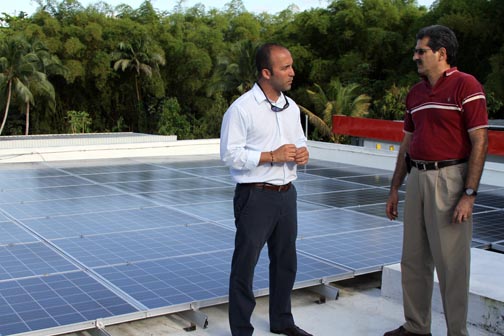Broadband service providers take Internet Protocol IPv6 training

Puerto Rico’s main broadband providers recently took part in the “IPv6 Workshop for Broadband Providers to begin preparing for the island’s transition to IPv6 — the next generation Internet Protocol.
The activity was sponsored by the Puerto Rico Bridge Initiative and the Internet Society at the Telegrafo facilities in Santurce, and included a presentation by IPv6 expert José Rosa of Cisco Systems. The topics addressed included IPv6 provisioning, transition and migration issues faced by broadband service providers.
In attendance were Network Engineers and representatives from broadband providers including Liberty, AT&T, Claro, OSNet, Caribe.Net, Worldnet, Aeronet, AWV Communications, WIFI Caribbean, as well as representatives from the University of Puerto Rico, the Internet Society of Puerto Rico and INTECO.
“There is no doubt about the importance of the Internet for Puerto Rico’s economic growth. Yet, less than 40 percent of our residents are broadband users,” said Carlo Marazzi, President of Critical Hub Networks, the company heading the PRBI that is pushing for broadband growth on the island through infrastructure being built with American Recovery and Reinvestment Act funding.
“Puerto Rico’s broadband providers are preparing to be able to provide broadband to millions of new users, and with faster speeds and greater redundancy. We are already seeing increased network investment by broadband providers,” he said. “The PRBI will continue to work with the broadband provider community to ensure that IPv6 is adopted so we can serve the next wave of Puerto Rico’s broadband users.”
In April 2010, Critical Hub was awarded $25.7 million in ARRA funds through the National Telecommunications and Information Administration to give life to the PRBI, a project designed to bring fast, affordable broadband service to all of Puerto Rico.
Since then, the PRBI has established an ultra high speed backbone connection for broadband providers from Puerto Rico to Miami. The next phase of the project will include a terrestrial wireless network to facilitate broadband speeds in areas that are particularly underserved, including Maricao, Vieques and Culebra.
What is IPv6?
Meanwhile, IPv6 is the sixth revision to the Internet Protocol, and the successor to the currently used IPv4. The explosion of the Internet in the past decade has made IPv6 adoption essential to facilitate its continued growth and provide the necessary IP addresses for new Internet users and devices.
The major difference between IPv4 and IPv4 is the number of IP addresses available. There are just over four billion IPv4 addresses (232), while there are 2128 IPv6 addresses, or in other words, IPv6 can support 340,000,000,000,000,000,000,000,000,000,000,000,000 devices.
“There are now two billion people who connect to the Internet. We’ve got six billion people in the world who want to connect themselves and their devices. That is simply not possible with IPv4. It’s just not doable,” said Olaf Kolkman, Internet Architecture Board (IAB) chair on Feb. 3, 2011 when the final IPv4 addresses were distributed to the Internet registries, including the American Registry for Internet Numbers.
“IPv6 is coming, and Puerto Rico is not ready,” said Karen Larson, vice president of Critical Hub Networks. “The Internet Society of Puerto Rico and the PRBI are going to continue our efforts in 2012 with the goal of having the majority of Puerto Rico’s broadband providers participate in World IPv6 Day in 2013.”










